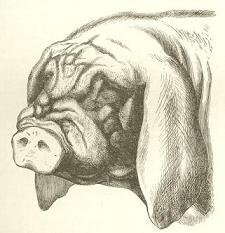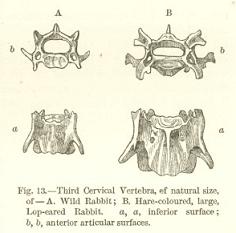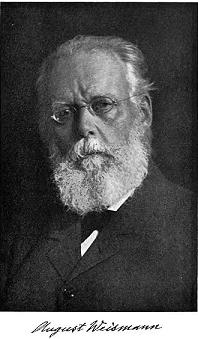
Understanding how individuals of the same species vary was key to Darwin developing his theory. He had begun noticing variability of individuals during the Beagle Voyage, but it was through his work on barnacles, and domestic plants and animals, that he came to see just how variable individuals are. This variability is vital for natural selection to work. Here we discuss how Darwin studied variation and what he thought about heritability.
Variation Under Domestication
In his Autobiography Darwin sums up The Variation of Animals and Plants under domestication as ‘a big book’ which cost him ‘four years and two months hard labour’. He began writing it, shortly after the publication of On the Origin of Species, in 1860 but it wasn’t until 1868 that it was finished and published. Work on the book was slowed by long periods of ill health and by Darwin getting distracted by ‘more interesting’ projects (between 1860 and 1868 he published three revised editions of The Origin, and two new books; On the Various Contrivances by Which British and Foreign Orchids are Fertilised by Insects (1862) and On the Movements and Habits of Climbing Plants(1865), both of which included much experimental work carried out by Darwin and his family of helpers.

In truth, Darwin had been working on it for longer than this. Originally he intended to publish his theory of evolution as a huge multi-volume monograph; his definitive account of the variability and evolution of life on earth. Events conspired against his plans though, as Darwin was pushed to publish an abstract of his ideas following Wallace’s development of a similar evolutionary mechanism. The Variation would have been a major chunk of Darwin’s big species book. In The Originhe had introduced the ideas this book contains; the plasticity of animal and plant species under artificial selection, and the inheritance of traits through generations.
The Variation was published in two volumes. The first deals with variation amongst domestic breeds, ramming home the point that species are highly plastic in form and behaviour. The second volume discusses what was then known about the laws of inheritance. In this volume Darwin adds a new theory into the mix, one which he had left out of The Origin; the theory of Pangenesis. Finally he used the book as a means to counter some arguments against The Origin, in particular Harvard botanist Asa Gray’s argument that the production of variation was divinely guided.
Darwin’s Studies Of Variation
Volume one presents the full amount of Darwin’s enquires on variation in domestic animals and plants which he had given glimpses of in the opening chapter of The Origin. As Darwin puts it: ‘it gives all my observations and an immense number of facts collected from various sources, about our domestic productions’. These facts serve to support the notion that species are not fixed, that they can and do change.
Its scope and depth demonstrates the rigour, enthusiasm and obsessive nature with which Darwin conducted his research and collected his facts. In successive chapters he deals with each class of domestic animal and plant in turn, detailing the variation between breeds, their similarities with their wild counterparts and the process by which artificial selection has acted on naturally occurring variation to produce the variety of form and behaviour seen in modern breeds.
In many cases these accounts are still the most thorough discussion of the products of artificial selection. No class of animal or plants escapes Darwin’s scrutiny; there are chapters on dogs and cats, horses and asses, pigs, cattle, sheep and goats, rabbits, two chapters on pigeons, fowl and an assortment of other birds, goldfish, bees, silkmoths, cereal and culinary plants, fruits, trees and flowers. Darwin’s dissection of the variety of breeds and races of domestic animals and plants extends to some characteristically obscure and amusing places. These include, for example, the offensive odour of domestic dogs and curious appendages to the jaws of pigs. The animal though that most captured Darwin’s attention was the pigeon, you can read more about his work with pigeon breeds here.

Why did Darwin accumulate such a mass of fact and observation on minute details of domestic breeds? His strategy was to document, as fully as possible, the cases, causes and consequences of variation in order to learn something about how it is produced, transmitted and how selection acts on it. As Darwin writes in the introduction of The Variation:
‘I shall in this volume treat, as fully as my materials permit, the whole subject of variation under domestication. We may thus hope to obtain some light, little though it be, on the causes of variability, - on the laws which govern it, such as the direct action of climate and food, the effects of use and disuse, and of correlation of growth, - and on the amount of change to which domesticated organisms are liable. We shall learn something on the laws of inheritance, on the effects of crossing different breeds, and on that sterility which often supervenes when organic beings are removed from their natural conditions of life, and likewise when they are too closely interbred. During this investigation we shall see that the principle of selection is all important. Although man does not cause variability and cannot even prevent it, he can select, preserve, and assimilate the variations given to him by the hand of nature in any way which he chooses.’
One important point Darwin was keen to address was the origin of variation. To Darwin variation was naturally produced according to some, as yet unknown, laws. The agent of selection, be it man or natural selection, had no hand in the variation with which it could work; it had to make do with what nature threw up. Some though, eager to keep a divine hand in the creation of species, argued that the production of variation was guided by a divine being. The most prominent exponent of this idea was Darwin’s American friend Asa Gray.
The Variation includes a personal rebuttal directed at Gray in the form of an anology. Darwin draws up the image of a cliff face with chunks of rock at its base which have been broken off naturally. He asks, if these rocks are used to build a house ‘can it be reasonably maintained that the Creator intentionally ordered… that certain fragments of rock should assume certain shapes to that the builder might erect his edifice?... Can it be maintained with any greater probability that he specially ordained for the sake of the breeder each of the innumerable variations in our domestic animals and plants?’. Darwin saw no hand for design in evolution by natural selection, nor in the production of variation. The mass of facts he collected provided the evidence on which he based his conclusions.
Darwin has shown through domestic breeds in this work, and in natural species in The Origin and elsewhere, that variation is rife, and is heritable, and can be selected for or against. These facts mean that in a natural world where each individual must compete to survive and breed, and where each individual differs in how well it does so, evolution is inevitable.
The Laws Of Inheritance & Pangenesis

The second volume of The Variation discuses ‘the causes and laws of variation, inheritance &c., [which"> are discussed as far as our present state of knowledge permits’. This discussion includes Darwin’s theory of inheritance, Pangenesis, which had not yet been published elsewhere despite it appearing in his notebooks in the 1840s, many years before the writing of The Origin.
Pangenesis had not been included in The Origin because it didn’t need to be. To show that evolution by natural selection occurs Darwin needed to demonstrate that variation exists, that it is heritable and that it can be selected upon: this he had done. Explaining how traits are inherited is another problem, one that didn’t need to be addressed in order to prove that evolution is a reality. The ultimate failure of Pangenesis therefore is not a problem for the theory of evolution, and whilst Pangenesis did not ultimately solve the mystery of inheritance, it was historically important for other reasons.
The process of Pangenesis goes something like this: each organ in the body, throughout an individual’s life produces small particles called ‘gemmules’. These gemmules contain information about the organ; how it is used or not used, its size, structure etc. When gemmules are released from an organ, they travel through the body to the sperm and eggs in the reproductive organs where they stick together. In this way the information could be passed on to the next generation, so explaining the heritability of variation.
This sounds very different to what we now know about the mechanism of inheritance (see below). How did Darwin get it so wrong? Darwin based this theory, as he did all his theories, on the evidence available to him. In this case the evidence was sparse and in some cases ‘accepted facts’ were unreliable (such as the effects of use and disuse; for example that men who develop big muscles due to using them a lot should have children with big muscles).
Darwin’s writing on Pangenesis in places alludes to an awareness that the evidence was not all there to support his ideas, even that he may well be wrong. He refers to Pangenesis as his ‘provisional hypothesis’ and in the introduction to the chapter in which he outlines the theory states:
‘I am aware that my view is merely a provisional hypothesis or speculation; but until a better one be advanced, it may be serviceable by bringing together a multitude of facts which are at present left disconnected by any efficient cause. As Whewell, the historian of the inductive sciences remarks:- “Hypotheses may often be of service to science, when they involve a certain portion of incompleteness, and even error”.’
In a similar vein, in his autobiography he writes of his ‘much-abused’ theory that:
‘An unverified hypothesis is of little or no value; but if anyone should hereafter be led to make observations by which some such hypothesis could be established, I shall have done good service’.
Very few accepted Pangenesis at the time but even so it was an important theory in the history of research into inheritance. By presenting his theory and giving supporting evidence Darwin identified the key facts that must be explained by a theory of inheritance and summarised what was then known. By doing so he highlighted areas where understanding was lacking, stimulating others to look at this important topic. All the early geneticists had to consider pangenesis, and the facts Darwin collected. This undoubtedly set them in the right mind frame to appreciate the rediscovered work of another great Victorian scientist: Mendel.
Weismann, Mendel & Modern Understanding Of Inheritance
Today we have an excellent idea of how inheritance works. Our modern theory of inheritance is based on principles developed within Darwin’s lifetime, and it is one of the great misfortunes in the history of science that he was never aware of them. This work, of course, was that of an Augustinian monk called Gregor Mendel. Mendel’s elegant breeding experiments provided the first steps in developing a realistic picture of inheritance. By focusing on discrete, easily distinguishable traits, such as flower colour, or whether the peas were wrinkled or not, he was able to discern key principles about the inheritance of traits, what we now call Mendel’s Laws.

Mendel published the results of his pioneering work, in a paper titled ‘Treatises on Plant Hybrids’, in 1866 but in the obscure journal ‘Records of the Brünn Association for Natural Research’. It went largely unnoticed, Mendel even sent out 40 copies to leading botanists but even then they failed to see the significance of his work (or perhaps didn’t think it would be worth reading). The one recipient to reply was encouraging, but redirected Mendel’s attention away from peas to hawkweed. This was bad advice, as hawkweed reproduces asexually and isn’t suitable for studying experimental crosses. Eventually, lack of success with the hawkweeds and increasing responsibilities at his monastery led Mendel to leave his work behind. Mendel’s work would go unnoticed for 34 years.
In the mean time other advances were made. The great German biologist August Weisman published his ‘germ plasm’ theory, a year after Darwin’s death, in 1883. The germ plasm theory states that a organism’s cells are divided into somatic cells (the cells that make up the body) and germ cells (cells that produce the gametes). His great insight was to see that the two do not exchange information – variation must be produced in the germ cells. Weisman firmly rejected the idea of acquired characteristics, which were central to the neo-Lamarkian evolutionary theories popular in the late 1800s. At this time natural selection was very unpopular and Weisman was one of the few, and probably the keenest, supporter of Darwin’s theory of natural selection. It’s a nice twist therefore, that his germ plasm theory dealt a death blow to one of Darwin’s other big ideas, Pangenesis.
The big breakthrough came when Mendel’s and Weisman’s ideas were combined. This happened when biologists rediscovered Mendel’s work in 1900. Biology now had it’s theory of inheritance and a new field, studying inheritance and variation was born and christened ‘genetics’ by William Bateson, a Cambridge zoologist.
The 20th century saw genetics blossom with a string of key discoveries. Thomas Hunt Morgan, working on flies in Columbia University, was the first to identify one of Mendel’s factors; a gene as it is now known. He was even able to pinpoint its position; genes reside in chromosomes in the nucleus.

Later work showed that it was a molecule known as DNA that carried the genetic information, DNA was coiled up and wrapped around proteins to form the chromosomes. In the 1950s the structure of DNA was discovered by Watson, Crick and others and, soon after, its code was deciphered to reveal how this information is translated to make proteins, the building blocks of cells. Continuing work since the 1950s has led us to an excellent and ever expanding understanding of how DNA builds complex organisms, and how DNA mutates to produce the variation Darwin described.
Written by Stephen Montgomery
References & Further Reading
The Autobiography of Charles Darwin
by Charles Darwin (Edited by Francis Darwin), The Thinker's Library: 1929
Darwin
by John van Wyhe, Andre Deutsch: 2009
Darwin
by Adrian Desmond & James Moore, Penguin: 1991
Darwin: Discovering the Tree of Life
by Niles Eldredge, WW Norton & Co.: 2005
On the Origin of Species
by Charles Darwin, 1859 (any reprint - 2nd edition preferable)
One Long Argument
by Ernst Mayr, Allen Lane: 1991
The Variation of Animals and Plants Under Domestication, Vol I & II
by Charles Darwin, 1868 (any edition)